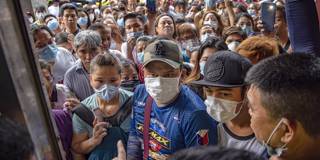The panic that often occurs during a health crisis or in the aftermath of a natural disaster can – and has – led to spasms of irrational violence. Lack of truthful public information can lead to conspiracy theories, which become lethal when politicians or the media deliberately stir them up.
NEW YORK – In September 1923, the Great Kanto earthquake devastated large parts of Tokyo, mostly owing to firestorms. Rumors spread, and were often repeated in the mainstream press, accusing Koreans, a despised and poor minority, of planning to take advantage of the disaster by starting a violent rebellion. Japanese vigilantes, armed with swords, bamboo spears, and even guns, then set upon anyone who sounded or looked Korean. Up to 6,000 people were murdered as police looked on and sometimes took part.
This was not some uniquely Japanese phenomenon. Mobs massacring unpopular minorities remain all too common. When Hindus started killing Muslims in Delhi recently, the Indian police were as passive, or as culpable, as the Japanese authorities were in 1923. One need not go far back in European or American history to find similar, or even worse, cases of lynching and mass murder.
Irrational violence often arises from panic. And panic can easily occur during a health crisis or in the aftermath of a natural disaster. Lack of truthful public information can lead to conspiracy theories, which become lethal when politicians or the media deliberately stir them up.

NEW YORK – In September 1923, the Great Kanto earthquake devastated large parts of Tokyo, mostly owing to firestorms. Rumors spread, and were often repeated in the mainstream press, accusing Koreans, a despised and poor minority, of planning to take advantage of the disaster by starting a violent rebellion. Japanese vigilantes, armed with swords, bamboo spears, and even guns, then set upon anyone who sounded or looked Korean. Up to 6,000 people were murdered as police looked on and sometimes took part.
This was not some uniquely Japanese phenomenon. Mobs massacring unpopular minorities remain all too common. When Hindus started killing Muslims in Delhi recently, the Indian police were as passive, or as culpable, as the Japanese authorities were in 1923. One need not go far back in European or American history to find similar, or even worse, cases of lynching and mass murder.
Irrational violence often arises from panic. And panic can easily occur during a health crisis or in the aftermath of a natural disaster. Lack of truthful public information can lead to conspiracy theories, which become lethal when politicians or the media deliberately stir them up.